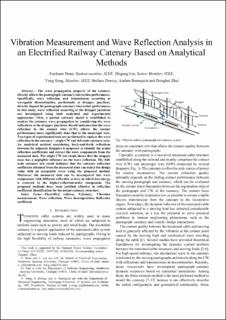| dc.contributor.author | Duan, Fuchuan | |
| dc.contributor.author | Liu, Zhigang | |
| dc.contributor.author | Song, Yang | |
| dc.contributor.author | Derosa, Stefano | |
| dc.contributor.author | Rønnquist, Anders | |
| dc.contributor.author | Zhai, Donghai | |
| dc.date.accessioned | 2021-11-16T09:30:54Z | |
| dc.date.available | 2021-11-16T09:30:54Z | |
| dc.date.created | 2021-03-18T09:44:50Z | |
| dc.date.issued | 2021 | |
| dc.identifier.citation | IEEE Transactions on Instrumentation and Measurement. 2021, 70 . | en_US |
| dc.identifier.issn | 0018-9456 | |
| dc.identifier.uri | https://hdl.handle.net/11250/2829758 | |
| dc.description.abstract | The wave propagation property of the catenary directly affects the pantograph–catenary interaction performance. Specifically, wave reflection and transmission occurring at waveguide discontinuities, particularly at dropper junctions, directly impact the pantograph–catenary interaction performance. In this study, wave reflection occurring at the dropper junctions is investigated using both analytical and experimental approaches. First, a partial catenary model is established to analyze the catenary wave propagation by considering the wave reflections at the dropper junctions. The result indicates that the wave reflection in the contact wire (CW) affects the contact performance more significantly than that in the messenger wire. Two types of experimental tests are performed to analyze the wave reflection in the catenary—single CW and full-scale catenary tests. An analytical method considering back-and-forth reflections between the adjacent droppers is proposed to identify the actual reflection coefficients and extract the wave components from the measured data. The single CW test result shows that the dropper mass has a negligible influence on the wave reflection. The full-scale catenary test result indicates that the catenary reflection coefficient obtained from the measured data can match the design value with an acceptable error using the proposed method. Moreover, the measured data can be decomposed into wave components with different reflection orders, in which less energy is centered in the higher-reflection-order component. The proposed methods have been justified effective in reflection coefficient identification for the actual catenary structure. | en_US |
| dc.language.iso | eng | en_US |
| dc.publisher | Institute of Electrical and Electronics Engineers (IEEE) | en_US |
| dc.title | Vibration Measurement and Wave Reflection Analysis in an Electrified Railway Catenary Based on Analytical Methods | en_US |
| dc.type | Peer reviewed | en_US |
| dc.type | Journal article | en_US |
| dc.description.version | acceptedVersion | en_US |
| dc.rights.holder | © IEEE. Personal use of this material is permitted. Permission from IEEE must be obtained for all other uses, in any current or future media, including reprinting/republishing this material for advertising or promotional purposes, creating new collective works, for resale or redistribution to servers or lists, or reuse of any copyrighted component of this work in other works. | en_US |
| dc.source.pagenumber | 12 | en_US |
| dc.source.volume | 70 | en_US |
| dc.source.journal | IEEE Transactions on Instrumentation and Measurement | en_US |
| dc.identifier.doi | 10.1109/TIM.2021.3063178 | |
| dc.identifier.cristin | 1898904 | |
| cristin.ispublished | true | |
| cristin.fulltext | postprint | |
| cristin.qualitycode | 1 | |
